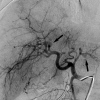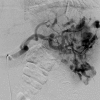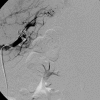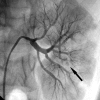Visceral trauma: principles of management and role of embolotherapy
- PMID: 21326517
- PMCID: PMC3036445
- DOI: 10.1055/s-0028-1085924
Visceral trauma: principles of management and role of embolotherapy
Abstract
Interventional radiology for the treatment of traumatic visceral hemorrhage has emerged as an important adjunct to modern trauma care. This article outlines the general surgical concepts of the acute care of trauma patients as a guideline for catheter-based therapy. Specific considerations are presented for embolizing visceral injuries in the liver, spleen, and kidney. Expected outcomes and follow-up are reviewed.
Keywords: Trauma; damage control laparotomy; hepatic embolization; hepatic hemorrhage; renal embolization; splenic embolization.
Figures













Similar articles
-
Interventional Radiology service provision and practice for the management of traumatic splenic injury across the Regional Trauma Networks of England.Injury. 2017 May;48(5):1031-1034. doi: 10.1016/j.injury.2017.02.031. Epub 2017 Feb 27. Injury. 2017. PMID: 28292519
-
Managing penetrating renal trauma: experience from two major trauma centres in the UK.BJU Int. 2018 Jun;121(6):928-934. doi: 10.1111/bju.14165. Epub 2018 Mar 13. BJU Int. 2018. PMID: 29438587
-
Interventional Radiology in Renal Trauma.Semin Intervent Radiol. 2021 Mar;38(1):113-122. doi: 10.1055/s-0041-1726006. Epub 2021 Apr 15. Semin Intervent Radiol. 2021. PMID: 33883808 Free PMC article. Review.
-
Surgical intervention for paediatric liver injuries is almost history - a 12-year cohort from a major Scandinavian trauma centre.Scand J Trauma Resusc Emerg Med. 2016 Nov 29;24(1):139. doi: 10.1186/s13049-016-0329-x. Scand J Trauma Resusc Emerg Med. 2016. PMID: 27899118 Free PMC article.
-
Non-operative management of hepatic trauma and the interventional radiology: an update review.Indian J Surg. 2013 Oct;75(5):339-45. doi: 10.1007/s12262-012-0712-4. Epub 2012 Aug 3. Indian J Surg. 2013. PMID: 24426473 Free PMC article. Review.
Cited by
-
Renal embolization for trauma: a narrative review.J Trauma Inj. 2024 Sep;37(3):171-181. doi: 10.20408/jti.2024.0021. Epub 2024 Sep 24. J Trauma Inj. 2024. PMID: 39428726 Free PMC article.
-
Celiac trunk arterial variations and their clinical implications: Role of imaging.Indian J Gastroenterol. 2024 Dec;43(6):1099-1110. doi: 10.1007/s12664-024-01656-5. Epub 2024 Sep 7. Indian J Gastroenterol. 2024. PMID: 39243342 Review.
-
Endovascular intervention in renovascular disease: a pictorial review.Insights Imaging. 2014 Dec;5(6):667-76. doi: 10.1007/s13244-014-0363-z. Epub 2014 Oct 12. Insights Imaging. 2014. PMID: 25304038 Free PMC article.
References
-
- Feliciano D V, Mattox D L, Moore E E. Trauma. 6th ed. San Francisco: McGraw-Hill; 2008. p. 1430.
-
- Kashuk J L, Moore E E, Millikan J S, Moore J B. Major abdominal vascular trauma–a unified approach. J Trauma. 1982;22(8):672–679. - PubMed
-
- Johnson J W, Gracias V H, Schwab C W, et al. Evolution in damage control for exsanguinating penetrating abdominal injury. J Trauma. 2001;51(2):261–269. discussion 269–271. - PubMed
-
- Parr M J, Alabdi T. Damage control surgery and intensive care. Injury. 2004;35(7):713–722. - PubMed
-
- Department of Defense Surface ship survivability. Naval War Publication 3-20.31. Washington, DC: U.S. Government Printing Office; 1996.

